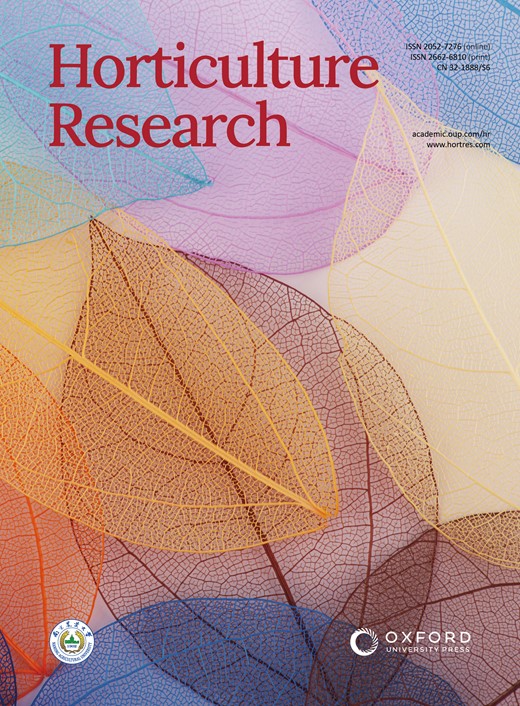Nitrogen reduces calcium availability by promoting oxalate biosynthesis in apple leaves
IF 8.7
1区 农林科学
Q1 Agricultural and Biological Sciences
引用次数: 0
Abstract
N and Ca are essential nutrients for apple growth and development. Studies have found that Ca content was not low under high N condition but was poorly available and could be easily fixed. However, the underlying physiological mechanism through which N regulates Ca availability remains unclear. In this study, apple plants were supplied with N and Ca to analyze the content, in situ distribution, and forms of Ca using noninvasive micro-test technique, electron probe microanalysis, Fourier transform infrared spectroscopy, and transcriptome analysis. A potential interaction was observed between N and Ca in apple leaves. The application of high N and Ca concentration led to a CaOx content of 12.51 g/kg, representing 93.54% of the total Ca in the apple leaves. Electron probe microanalysis revealed that Ca deposited in the phloem primarily existed as CaOx rhombus-shaped crystals. Additionally, high N positively regulated oxalate accumulation in the leaves, increasing it by 40.79 times compared with low N concentration. Specifically, N induced oxalate synthesis in apple leaves by upregulating the ICL, OXAC, and MDH genes, while simultaneously inhibiting degradation through downregulation of the AAE3 gene. Transcriptome and correlation analyses further confirmed oxaloacetate as the precursor for the synthesis of CaOx crystals in the apple leaves, which were produced via the “photosynthesis/glycolysis -oxaloacetate -oxalate -CaOx” pathway. WGCNA identified potential regulators of the CaOx biosynthesis pathway triggered by N. Overall, the results provide insights into the regulatory through which N regulates Ca availability in apple leaves and support the development of Ca efficient cultivation technique.氮通过促进苹果叶片中草酸盐的生物合成来降低钙的可用性
氮和钙是苹果生长和发育所必需的养分。研究发现,在高氮条件下,钙含量并不低,但可利用性差,且容易被固定。然而,氮调节钙的潜在生理机制仍不清楚。本研究给苹果植株提供了氮和钙,利用无创微测技术、电子探针显微分析、傅立叶变换红外光谱和转录组分析,分析了钙的含量、原位分布和形态。在苹果叶片中观察到氮和钙之间存在潜在的相互作用。施用高浓度氮和钙后,苹果叶片中的 CaOx 含量为 12.51 克/千克,占总 Ca 的 93.54%。电子探针显微分析表明,沉积在韧皮部的钙主要以 CaOx 菱形晶体的形式存在。此外,高浓度氮对叶片中草酸盐的积累有正向调节作用,与低浓度氮相比,草酸盐的积累增加了 40.79 倍。具体来说,氮通过上调 ICL、OXAC 和 MDH 基因诱导苹果叶片中草酸盐的合成,同时通过下调 AAE3 基因抑制草酸盐的降解。转录组和相关分析进一步证实,草酰乙酸是苹果叶片中合成 CaOx 晶体的前体,这种晶体通过 "光合作用/糖酵解-草酰乙酸-草酸盐-CaOx "途径产生。总之,该研究结果为了解氮如何调控苹果叶片中 Ca 的供应提供了重要信息,并为开发 Ca 高效栽培技术提供了支持。
本文章由计算机程序翻译,如有差异,请以英文原文为准。
求助全文
约1分钟内获得全文
求助全文
来源期刊

Horticulture Research
Biochemistry, Genetics and Molecular Biology-Biochemistry
CiteScore
11.20
自引率
6.90%
发文量
367
审稿时长
20 weeks
期刊介绍:
Horticulture Research, an open access journal affiliated with Nanjing Agricultural University, has achieved the prestigious ranking of number one in the Horticulture category of the Journal Citation Reports ™ from Clarivate, 2022. As a leading publication in the field, the journal is dedicated to disseminating original research articles, comprehensive reviews, insightful perspectives, thought-provoking comments, and valuable correspondence articles and letters to the editor. Its scope encompasses all vital aspects of horticultural plants and disciplines, such as biotechnology, breeding, cellular and molecular biology, evolution, genetics, inter-species interactions, physiology, and the origination and domestication of crops.
 求助内容:
求助内容: 应助结果提醒方式:
应助结果提醒方式:


